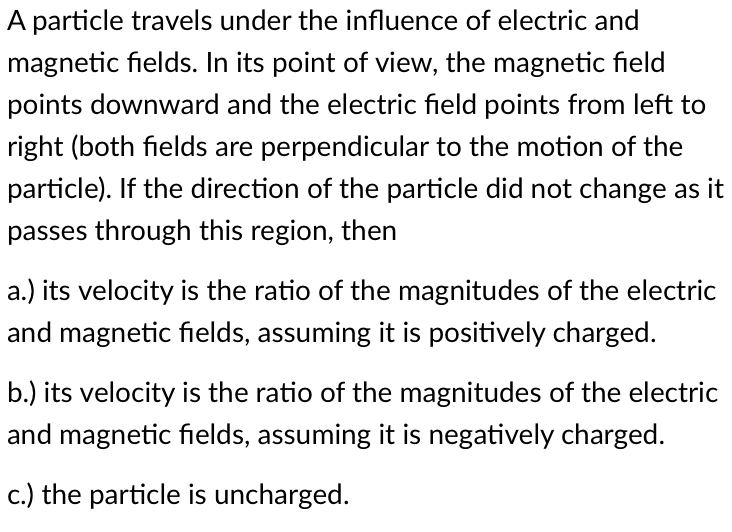A particle travels under the influence of electric and magnetic fields. In its point of view, the magnetic field points downward and the electric field points from left to right (both fields are perpendicular to the motion of the particle). If the direction of the particle did not change as it passes through this region, then a.) its velocity is the ratio of the magnitudes of the electric and magnetic fields, assuming it is positively charged. b.) its velocity is the ratio of the magnitudes of the electric and magnetic fields, assuming it is negatively charged. c.) the particle is uncharged.
A particle travels under the influence of electric and magnetic fields. In its point of view, the magnetic field points downward and the electric field points from left to right (both fields are perpendicular to the motion of the particle). If the direction of the particle did not change as it passes through this region, then a.) its velocity is the ratio of the magnitudes of the electric and magnetic fields, assuming it is positively charged. b.) its velocity is the ratio of the magnitudes of the electric and magnetic fields, assuming it is negatively charged. c.) the particle is uncharged.
Chapter11: Magnetic Forces And Fields
Section: Chapter Questions
Problem 28P: An electron in a TV CRT moves with a speed of 6.0107 m/s, in a direction perpendicular to Earth's...
Related questions
Question

Transcribed Image Text:A particle travels under the influence of electric and
magnetic fields. In its point of view, the magnetic field
points downward and the electric field points from left to
right (both fields are perpendicular to the motion of the
particle). If the direction of the particle did not change as it
passes through this region, then
a.) its velocity is the ratio of the magnitudes of the electric
and magnetic fields, assuming it is positively charged.
b.) its velocity is the ratio of the magnitudes of the electric
and magnetic fields, assuming it is negatively charged.
c.) the particle is uncharged.
Expert Solution
This question has been solved!
Explore an expertly crafted, step-by-step solution for a thorough understanding of key concepts.
Step by step
Solved in 2 steps with 1 images

Knowledge Booster
Learn more about
Need a deep-dive on the concept behind this application? Look no further. Learn more about this topic, physics and related others by exploring similar questions and additional content below.Recommended textbooks for you


Glencoe Physics: Principles and Problems, Student…
Physics
ISBN:
9780078807213
Author:
Paul W. Zitzewitz
Publisher:
Glencoe/McGraw-Hill

Physics for Scientists and Engineers: Foundations…
Physics
ISBN:
9781133939146
Author:
Katz, Debora M.
Publisher:
Cengage Learning


Glencoe Physics: Principles and Problems, Student…
Physics
ISBN:
9780078807213
Author:
Paul W. Zitzewitz
Publisher:
Glencoe/McGraw-Hill

Physics for Scientists and Engineers: Foundations…
Physics
ISBN:
9781133939146
Author:
Katz, Debora M.
Publisher:
Cengage Learning

Principles of Physics: A Calculus-Based Text
Physics
ISBN:
9781133104261
Author:
Raymond A. Serway, John W. Jewett
Publisher:
Cengage Learning